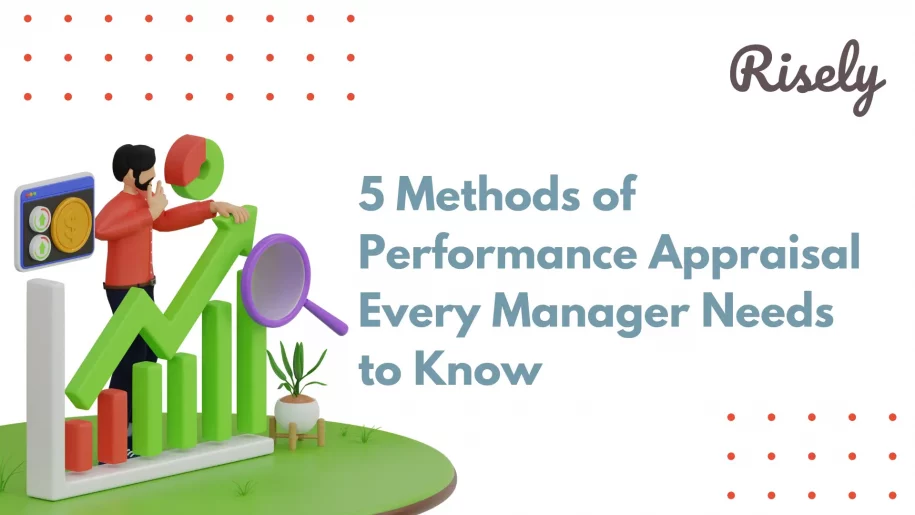5 Methods of Performance Appraisal Every Manager Needs to Know
Performance appraisal is a critical tool every manager should know and use to improve employee performance. It helps identify employees’ strengths, weaknesses, and areas of improvement. Performance appraisal allows managers to provide feedback to employees, set goals, and create development plans for them. This blog will discuss performance appraisal and why it is essential for managers. We will also cover the five most effective performance appraisal methods used by managers, including Management by Objectives (MBO), 360-degree Feedback, Behavioral Observation Scale (BOS), Critical Incident Technique (CIT), and Self-Evaluation Method. Additionally, we will share best practices for conducting a performance appraisal meeting, including preparing for the conference, delivering effective feedback, and setting performance improvement goals. Lastly, we will explore the impact of performance appraisal on employee motivation and engagement and how managers can incorporate effective performance appraisal methods in their organizations.What is Performance Appraisal?
Performance appraisal is a crucial process that allows managers to assess employee performance, provide feedback, and identify areas of improvement. It plays a vital role in effective performance management and employee development. Performance appraisal is crucial for managers as it allows them to evaluate employee performance objectively. It serves as a basis for making promotions, rewards, and training decisions. Additionally, performance appraisal enhances communication, helps identify areas for improvement, and aligns employee performance with organizational goals.The 5 Most Effective Methods of Performance Appraisal for Managers
When evaluating employee performance, managers have various methods to choose from. These methods give managers valuable insights into employee performance and contribute to effective performance appraisal.Performance Appraisal Method 1: Management by Objectives (MBO)
Management by Objectives (MBO) is a performance appraisal method that sets clear goals and objectives for employees. By encouraging collaboration between managers and employees in goal setting, MBO promotes a sense of ownership and accountability. This method focuses on results and performance outcomes, aligning individual goals with organizational objectives. MBO fosters employee engagement and increases their commitment to achieving the desired outcomes. With its emphasis on clear objectives and measurable results, MBO provides a structured approach to performance appraisal that promotes organizational productivity and growth.Performance Appraisal Method 2: 360-Degree Feedback
360-degree feedback is a method that gathers input from various perspectives, including peers, subordinates, and superiors. It offers a comprehensive view of an employee’s performance, promoting self-awareness and encouraging feedback. This method helps identify improvement and development areas, fostering a continuous growth culture. With 360-degree feedback, managers can better understand their team members’ strengths and weaknesses. By incorporating this modern approach to performance appraisal, organizations can enhance their human resource management practices, improve employee morale, and align individual goals with company objectives. The feedback received through 360-degree review goes beyond traditional performance assessment methods, providing valuable insights into employees’ skills, interpersonal relationships, and leadership abilities.Performance Appraisal Method 3: Behavioral Observation Scale (BOS)
Behavioral Observation Scale (BOS) assesses employee performance using specific behavioral examples. This method provides a clear framework for evaluating performance, ensuring consistency and objectivity in the appraisal process. By emphasizing observable behaviors rather than subjective opinions, BOS promotes fair evaluations and enables managers to provide specific feedback for improvement. The BOS method is effective for HR professionals and managers who want to enhance employee productivity and morale. It eliminates the subjectivity associated with traditional performance appraisal methods and encourages a more objective assessment based on tangible behaviors.Performance Appraisal Method 4: Critical Incident Technique (CIT)
The Critical Incident Technique (CIT) is a method used in performance appraisal that involves recording and evaluating significant incidents of employee performance. Unlike other appraisal methods, CIT focuses on positive and negative incidents, providing a balanced view of employee performance. By highlighting specific examples of behavior, CIT helps managers identify strengths and areas for improvement. This method promotes objective assessment based on real-life situations, allowing for a more accurate evaluation of an employee’s performance. Incorporating the CIT method into the performance appraisal process can result in more meaningful employee assessments and valuable feedback.Performance Appraisal Method 5: Self-Evaluation Method
The Self-Evaluation Method is a valuable approach allowing employees to assess their performance. This method promotes employee engagement in the appraisal process by encouraging self-reflection and self-awareness. It gives managers valuable insights into employee perspectives and self-perception, fostering a sense of ownership and accountability. Unlike traditional performance appraisal methods, the Self-Evaluation Method reduces subjectivity and time-consuming processes. Employees can evaluate their skills, productivity, and progress toward company goals through questions or a checklist. This method enhances employee morale and encourages continuous improvement and growth.Best Practices for Conducting a Performance Appraisal
- Preparing in advance: It is essential to prepare in advance for the meeting. It involves gathering relevant information and documentation about the employee’s performance, such as previous performance reviews, performance review questions and applicable metrics or key performance indicators.
- Clarify expectations: Setting clear expectations and goals with the employee is also crucial. By clearly communicating what the team expects from them and what they should aim to achieve, you provide a framework for assessment and improvement.
- Give details and explain your ideas: Providing specific examples to support your feedback during the appraisal is essential. It helps the employee understand where they excel and areas that need improvement.
- Facilitate healthy communication: Encouraging open and honest communication during the assessment creates a safe space for the employee to provide input and share any concerns.
- Review and revise goals: Finally, following up after the appraisal to monitor progress and provide ongoing support is essential. It shows the employee that their development is significant and that you are invested in their success.
Preparing for the Performance Appraisal Meeting
There are several essential steps to take to ensure a successful performance appraisal meeting:- Thoroughly review the employee’s performance and gather relevant data. It will provide a comprehensive understanding of their strengths and areas for improvement.
- Set an agenda for the appraisal meeting to keep the discussion focused and organized. It’s also crucial to prepare specific examples of the employee’s achievements and areas for improvement, as this will serve as concrete evidence during the conversation.
- Consider the employee’s goals, job description, and performance standards to tailor the appraisal to their needs.
- Plan for a constructive and collaborative discussion during the meeting, fostering open dialogue and encouraging employees to share their perspectives.
Delivering Effective Feedback
Delivering effective feedback is crucial in helping employees understand areas for improvement and grow professionally. Timely feedback allows them to make necessary adjustments and enhance their performance. By providing clear and specific feedback, managers help employees understand expectations, resulting in improved performance. Using a balanced approach, incorporating positive and constructive feedback, is essential as this encourages employee engagement and motivation. Regular feedback sessions foster open communication and build trust between managers and team members. It promotes a collaborative work environment and contributes to the overall success of the performance appraisal process.Setting Performance Improvement Goals
Setting SMART goals (Specific, Measurable, Achievable, Relevant, Time-bound) is essential for employees to focus on tangible outcomes and drive their performance. Clearly defining goals provides employees direction and purpose in their work, ensuring they are aligned with organizational objectives. Managers can foster ownership and commitment to achieving desired results by involving employees in the goal-setting process. Regularly reviewing and revising goals enables adjustments to be made, keeping them relevant and driving continuous improvement. Monitoring progress towards these goals helps identify areas for growth and provides opportunities for coaching and support, ensuring ongoing development.Conclusion
To summarize, performance appraisal is a crucial aspect of effective people management. By utilizing suitable methods, managers can evaluate employee performance, provide constructive feedback, and set goals for improvement. It not only boosts individual growth but also enhances overall organizational performance. The five most effective methods of performance appraisal include Management by Objectives (MBO), 360-degree Feedback, Behavioral Observation Scale (BOS), Critical Incident Technique (CIT), and Self-Evaluation Method. However, managers must follow best practices during the appraisal process, such as thorough preparation, delivering effective feedback, and setting performance improvement goals. By incorporating these methods in their organizations, managers can promote employee motivation and engagement, leading to long-term success.Keep your feedback skills sharp to help your team win!
Are you ready to leave mistakes behind? Start the free constructive feedback assessment for managers now.
Other Related Blogs
How to build and retain high performing employees? | Laletha Nithiyanandan
How to build and retain high performing employees? | Laletha Nithiyanandan Are you really an HR if you have not spent hours chasing the ideal high performing employees for your…
How Can You Build A High Performing Culture? 7 Hacks
How Can You Build A High Performing Culture? 7 Hacks We have all heard of dream teams and tried to build them with varying levels of success and failure. Among…
10 Effective Manager Performance Goals to Drive Team Success
10 Effective Manager Performance Goals to Drive Team Success You’re sitting across from a manager in a performance review meeting. They seem unsure, disconnected from the company’s vision, and oblivious…
How to Build a High-Performing Team?
How to Build a High-Performing Team? Creating a high-performing team is a goal that every organization aspires to achieve. A high-performing team achieves superior results and can quickly adapt to…


